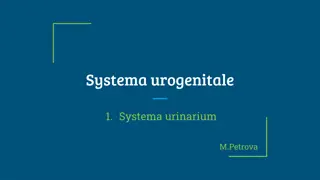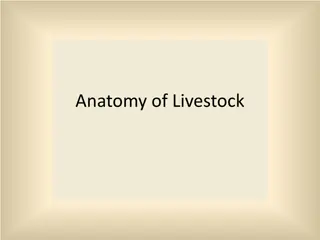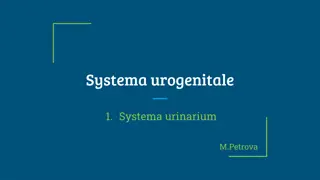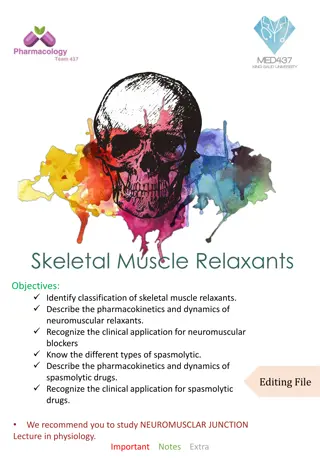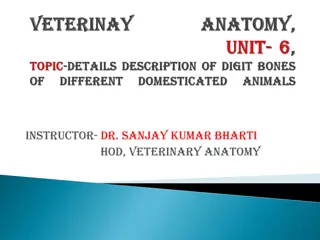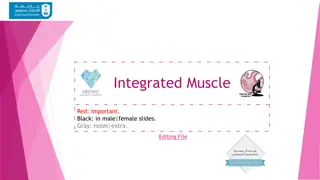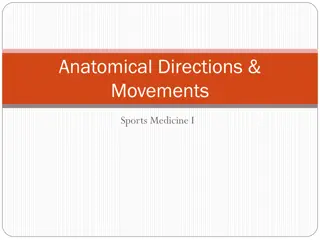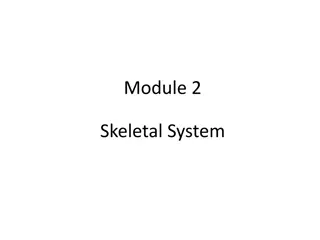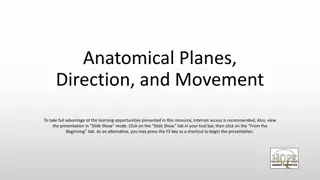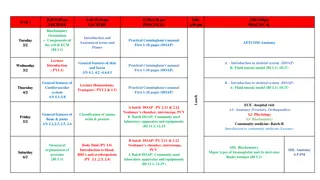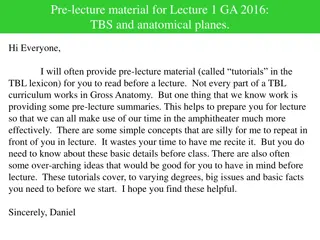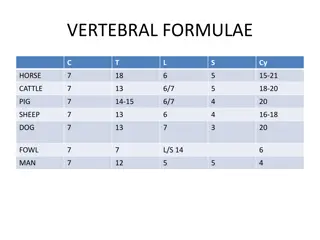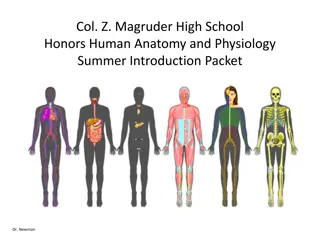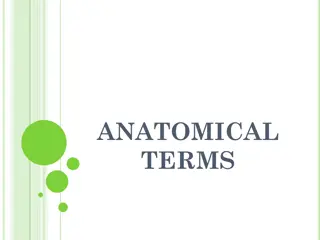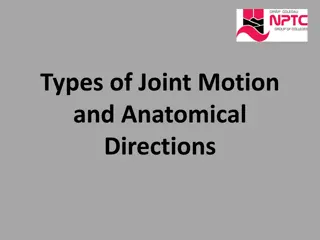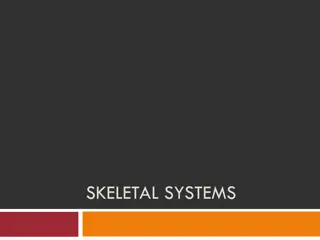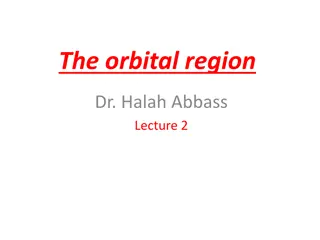Introduction to Anatomy: Anatomical Terms and Skeletal System
An introduction to anatomy covering anatomical terms and the skeletal system. It defines anatomy, explains anatomical sciences, discusses the skeletal system, and outlines anatomical terminology including terms of position. The content includes objectives, classifications of bones, and different anatomical fields. Various types of anatomy like gross, microscopic, developmental, radiological, applied, surgical, and cross-sectional are also explored.
Download Presentation

Please find below an Image/Link to download the presentation.
The content on the website is provided AS IS for your information and personal use only. It may not be sold, licensed, or shared on other websites without obtaining consent from the author. Download presentation by click this link. If you encounter any issues during the download, it is possible that the publisher has removed the file from their server.
E N D
Presentation Transcript
FIRST LECTURE Introduction to Anatomy Introduction to Anatomy ANATOMICAL TERMS AND SKELETAL SYSTEM
SKELETAL SYSTEM:BONE SKELETAL SYSTEM:BONE Objectives: 1. Define the word ANATOMY 2. Enumerate the different anatomical fields 3. Describe the anatomical position 4. Describe different anatomical terms of position and movements as well different anatomical planes 5. Classify bones according to shape , structure and development 6. Enumerate different bones of both axial and appendicular skeleton
What is Anatomy? What is Anatomy? It s the Study that deals with the structure and shape of the Body parts & their relationships to one another.
ANATOMICAL SCIENCES ANATOMICAL SCIENCES 1. Gross Anatomy : The study of human body with a naked eyes 2. Microscopic Anatomy ( Histology ) : Study of fine structure (cell and tissue ) of the human body with the help of microscope 3. Developmental Anatomy ( Embryology ) 4. Radiological Anatomy : Study of bodily structure using radiograph and other imaging methods 5. Applied Anatomy: The practical application knowledge to diagnosis and treatment 6. Surgical Anatomy: Study of anatomical structure in reference to the surgical diagnosis and treatment 7. Cross sectional Anatomy: Studying the humane body through a transverse cut through a structure or tissue
Skeletal System Skeletal System Includes: 1.Bones 2.Joints(Articulations between bones)
Anatomical Terminology : Anatomical Terminology : To prevent misunderstanding a special set of terms are used to describe identification and location of body structures . Anatomical position : The standard position in which the body assume to describe its parts . This position has 4 features : 1- Body is erect 2- Feet parallel 3- Palm facing forward 4- Arms hanging by the side
Terms of Position: Terms of Position: Superior (cranial ,rostral ): near to head . Inferior (Caudal): away from head. Anterior ( ventral ): near to front . Posterior (dorsal) : near to back. Medial : near to median plane Lateral : away from median plane Proximal : near to trunk Distal : away from trunk Superficial : near to skin (surface) Deep : away from skin *Intermediate: the relative location of an anatomical structure lying between two other structures:
ANATOMICAL PLANES & SECTIONS ANATOMICAL PLANES & SECTIONS Sagittal (median): Sagittal (median): - A cut made along a longitudinal plane dividing the body into 2 equal halves (right & left). - The plane passing through the midline of the body, cutting the body into the right and left equal halves is called a midsagittal or median plane. Parasagittal (paramedian): Parasagittal (paramedian): - divides the body into 2 unequal parts (right & left). Frontal (coronal): Frontal (coronal): - A cut made along a longitudinal plane. - divides the body into anterior & posterior parts Transverse (cross): Transverse (cross): - A cut made along a horizontal plane. - divides the body into superior & inferior parts.
Terms of Regions: Terms of Regions: Cranial (cephalic) Cervical Thoracic Abdominal Pelvic Plantar Palmar
Body Cavities Body Cavities There is two sets of internal cavities which are ventral ventral and dorsal dorsal . Ventral Body Cavity: divided by the diaphragm into: 1. Thoracic Cavity: : superior to diaphragm (above the diaphragm),contains heart & lungs. 2. Abdominal cavity: inferior to diaphragm (below the diaphragm) contains stomach, intestine, liver, urinary bladder, etc Dorsal body cavity: : divided into 2 parts continuous with each other: 1. Cranial cavity: : space inside skull, contains brain. . 2. . Spinal cavity: : space inside vertebral column, contains spinal cord.
Abdominopelvic Regions Abdominopelvic Regions The Abdominopelvic area is divided into 9 regions by 2 vertical & 2 horizontal lines or planes. Objective: Objective: To locate the different organs in each region.
TERMS OF MOVEMENT TERMS OF MOVEMENT 1 1- -3 3 Flexion: approximation of 2 parts (decreasing the angle between 2 parts) Extension: straightening (increasing the angle between 2 parts) Abduction: away from median plane Adduction: towards median plane Lateral rotation: rotation away from median plane Medial rotation: rotation toward median plane Circumduction: combined movements of flexion, extension, abduction &
TERMS OF MOVEMENT TERMS OF MOVEMENT 2 2- -3 3 -Opposition Opposition: bringing tips of fingers and thumb together as in picking something up - -Supination Supination: - Lateral rotation of the forearm. - The palm faces Anteriorly. - The radius and ulna are Parallel. - Pronation: Pronation: - Medial rotation of the forearm. - The palm faces Posteriorly - The radius Crosses the ulna and the two bones form an X.
TERMS OF MOVEMENT TERMS OF MOVEMENT 3 3- -3 3 Planterflexion: - Depressing the foot (down ). - Movement with pointing the toes. Dorsiflexion: - Up movement of the foot - (Standing on the heels) Inversion: The sole faces in a Medial direction. Eversion: The sole faces in a Lateral direction. https://youtu.be/5YcNAPzDxDg
Functions of bone Functions of bone attachment to muscles support protection Blood cell formation storage of fat and minerals movement e.g.: Calcium and phosphorus
Classification on bone Bones are classified based on three Bones are classified based on three things things: 1- Shape Shape: Long, Short, Irregular , flat 2- Structure Structure: Compact, Spongy 3- Development Development: : Membrane, Cartilage
The Skeleton The Skeleton The skeleton is formed from 206 Bones The Skeleton Axial Skeleton Appendicular Skeleton Pectoral and pelvic Girdles Upper and lower limbs Vertebral columns Skull Sternum Ribs
Bones of the axial skeleton The Skull The Skull Formed from two sets of bones: Formed from two sets of bones: 1. Cranium(bones enclosing and covering the brain): Frontal, Temporal, Occipital, Parietal, Sphenoid 2. Facial bones (bones that form the skeleton of the face): Maxilla, Nasal, Zygomatic, Mandible
VERTEBRAL COLUMN VERTEBRAL COLUMN It is a flexible curved structure formed of 33 vertebrae (irregular bones) Running through its cavity is the spinal cord Formed of : 1) Cervical vertebrae 7 7 2) Thoracic vertebrae 12 12 3) Lumbar vertebrae 5 5 4) Sacral vertebrae fused to form sacrum (triangular bone) 5 5 5) coccygeal vertebrae fused to form coccyx (small bone) 4 4
Sternum (Flat bone) : Sternum (Flat bone) : Has 3 parts : 1.Manubrium 2.Body 3.xiphoid process Ribs : Ribs : Number: vertebrae 12 pairs All ribs articulate with vertebrae Only upper 7 pairs articulate with sternum The first 7 are called true ribs The ribs 8,9 and 10 are called False ribs The ribs 11 and 12 are called Floating ribs
BONES OF APPENDICULAR SKELETON BONES OF APPENDICULAR SKELETON PECTORAL GIRDLE Connects upper limb with axial skeleton Formed of: clavicle & scapula (2 bones on each side) PELVIC GIRDLE Connects lower limb with axial skeleton Formed of: hip bone (one bone on each side)
BONES OF APPENDICULAR SKELETON UPPER LIMB Bone of arm: humerus Bones of forearm: radius (lateral) & ulna (medial) Bones of hand: 8 carpal bones 5 metacarpal bones 14 phalanges: 2 for the thumb & 3 for each of medial 4 fingers
BONES OF APPENDICULAR BONES OF APPENDICULAR SKELETON SKELETON Lower limp Bones of thigh Femur . Bones of leg Fibula (lateral) & Tibia (medial). Patella. Bones of foot : i. 7 tarsal bones . ii. 5 metatarsal bones . iii. 14 phalanges : 2 for big toe & 3 for each four lateral toes .
LONG BONES LONG BONES metaphysis metaphysis (The region between (The region between diaphysis and diaphysis and epiphysis) epiphysis) Diaphysis Diaphysis (shaft) (shaft) - - long & cylindrical long & cylindrical - - Compact bone Compact bone contains thin plate of contains thin plate of cartilage called the cartilage called the epiphyseal plate epiphyseal plate that is responsible for the responsible for the lengthwise growth of the lengthwise growth of the long bones. long bones. - Covered on its external Covered on its external surface by a fibrous surface by a fibrous connective tissue connective tissue membrane called the membrane called the periosteum periosteum. . that is - Has a cavity called the Has a cavity called the marrow cavity marrow cavity. . In adults, the marrow cavity marrow cavity is a storage area for is a storage area for fat contains contains yellow marrow yellow marrow. . In infants, it infants, it contains contains red marrow red marrow and is the site of the site of blood cells blood cells formation formation In adults, the fat and and In and is
Periosteum Role of Periosteum: Protects the bone Gives attachment to muscles Carries blood vessels and nerves to bone Deposits new bone on the surface thus increases the girth of bone
LONG BONES LONG BONES Epiphysis Epiphysis (The two ends) (The two ends) - Spongy Bone Spongy Bone - lined by a thin layer of compact bone lined by a thin layer of compact bone - Its external surface is covered by a layer of Its external surface is covered by a layer of hyaline cartilage called the called the articular cartilage articular cartilage (provides smooth slippery surface (provides smooth slippery surface that decreases friction at joint surfaces that decreases friction at joint surfaces) ) hyaline cartilage *Growth of bone Increase in length: epiphyseal plates Increase in girth: periosteum*
Some links to learn more: Videos: https://www.youtube.com/watch?v=rDGqkMHPDqE&feature=youtu. be https://www.youtube.com/watch?v=uBGl2BujkPQ https://www.khanacademy.org/science/health-and- medicine/human-anatomy-and-physiology/skeletal- system/v/skeletal-structure-and-function https://www.youtube.com/watch?v=TnY6l9hMOew&feature=youtu.b e Online quiz: https://www.onlineexambuilder.com/anatomical- terminology-skeletal-system/exam-35333 https://www.onlinequizcreator.com/anatomical- terms-and-skeletal-system/quiz-208453
Credits: Credits: Team leaders: Team leaders: Team members: Team members: Abdullah Jammah Abdulmalik Alhadlaq Majed Alzain Yazeed Alsuhaibani Rakan Bahammam Mosaed Alnowaiser Khalid Aleedan Mohammed Alyousef Mohammed Nasr Mohammed Ghandour Dania Alkelabi Heba Alnasser Deena Alnowiser Jawaher Alkhayyal Rana Barasain Wejdan Alzaid Shouq Albogami Lara Alsaleem Ghadah Almazrou Ameera NIazi Lama Alfozan Nawaf Alkhudairy Jawaher Abanumy



